
Red Army Uniforms
In the early period of 1918 the Red Army men were in their WWI gear, the sailors in naval gear and the worker units largely in civilian clothes. It was considered rather chic to appear rather shabby (to indicate your proletarian inclinations, rather than bourgeois smartness).
Later as those clothes wore out the replacements might be from the WWI stocks, but from entirely different units. The result was a chaotic mix. Almost every photo of Red Army soldiers where they are all wearing the same uniform is in the rear, and as often as not commanders or kursanty. Photos taken at the front generally show men in a vast range of hats, coats, shirts and kit.
As makeshift as the Red Army uniforms were, they were generally at least equipped with something that functioned. The White Armies, other than a few of the older "Officer" units, were more poorly dressed in general.
Reference works
Osprey Publishing put out in 1996 "The Russian Civil War (I) The Red Army". The text is rather too focused on the regulations, even while admitting that they were largely ignored, and so of less use to gamers than it might be. Much of it is lifted straight from the official RCW encyclopedia. The illustrations are excellent, but only A1, A2, B2, C1 and C3 depict the uniforms of a typical soldier.
Osprey's "Armies of the Russo-Polish War, 1919-1920" also has a couple of good photos of troops at the front and illustrations B2, C3, F1 and H3 are of normal soldiers.
Osprey's "The Russian Army, 1914-1918" shows and describes the WWI items usually worn in practice in much more detail. Of course the illustrations are of men with Tsarist shoulder-boards, cockades etc, and altogether too tidy for the RCW period. Still, it is probably the best book to start with.
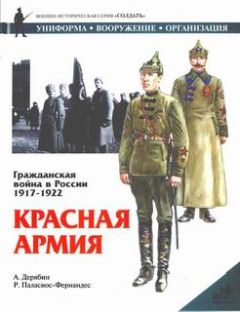
AST put out a book in 2000, "The Civil War in Russia 1917-1922, Red Army". It suffers from the same issues as the matching Osprey from a gamer's perspective, with a focus on unusual troops and official uniforms rather than run-of-the-mill infantry, cavalry and artillery.
It can be hard to find now, but there is an English translation available, and many of the plates are on-line.
Uniform Items
I will not duplicate the reference materials with regard to technical details. However it can be hard for newcomers to the field to make sense of the scattered and often contradictory information – especially as regulations were almost completely ignored.
The 1919 Uniform
The official uniform of first promulgated in January 1919 was basically never seen in the RCW. I shall pass over it briefly.
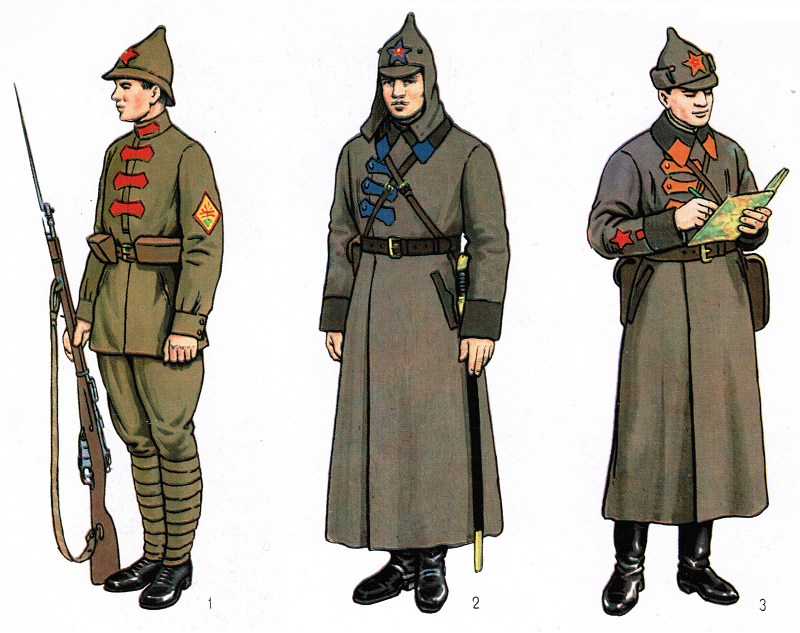
1 is an infantryman in summer uniform. The branch of service colours for rifle units was raspberry (often translated as "crimson") which tended to fade to pink, but seems in practice to often have been red, as here. The coloured tabs on the shirt were khaki in the field.
2 is a cavalryman from the branch of service blue. He has the winter shlem unbuttoned.
3 is an artilleryman, from the orange colour, and a platoon commander from the sleeve insignia.
Engineers had black as the branch colour.
Headgear
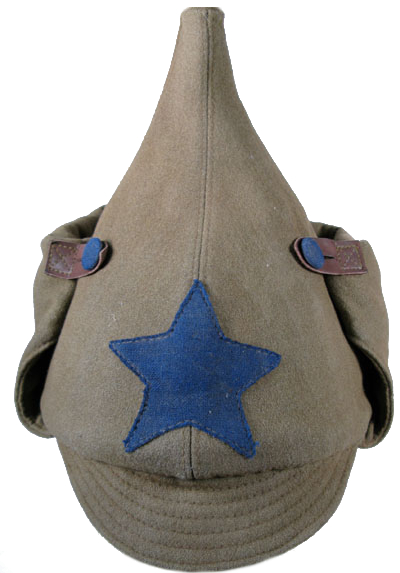
The famous pointy shlem hat in the winter version does seem to have been one of the first items of the regulation uniform to have been made in any number, and you see units in 1920 with significant numbers of them.
The regulation was to have a red hammer and plough tin badge pinned to the middle of the cloth star, but in practice many didn't.
Instead in summer most men wore a peaked cap, furazhka. Most were ex-WWI stock, but usually with the stiffener taken out to soften it. The old cockade was taken off, but the new ones were not always added.
It was quite popular to push the crown of the cap far back, with a crease in the middle. A nice military cap worn straight is often a sign the wearer was a "military specialist" (former officer).
A lot of working men's caps were also worn, but they look so similar to the beaten-up varieties of the military caps that they can be hard to spot.
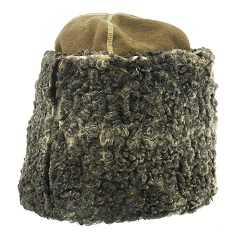
In winter the various woolen and fur hats tended to dominate. Generally infantry had papakha in the light weight lambs wool military version, shown left.
Cavalry often had heavier weight fur hats, although they were seen on infantry too. The hats got furrier as one headed east.
The low version of the fur hats, the kubanka was associated with the Cossacks, and pretty much only worn by them.
Blouse
Newcomers to period often ask what colour is the "correct" khaki. There is no such colour.
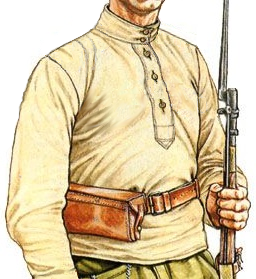
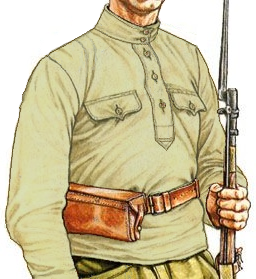
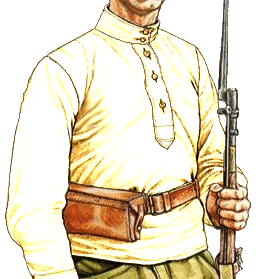

The WWI summer blouse (gymnastiorka, rubashka) might be yellowish, brownish or greenish khaki. It often faded to near white over time, as can be seen in many of the photographs of the period. Some had pockets. The 1919 regulation ones were light grey, but not often seen.
The winter version were wool, and seem to have been darker and kept their colour better.
Many men, especially commanders, wore the various former officer tunics when they could find them. These also came in a wide variety of khaki shades, and are also seen in black (both cloth and leather).
Trousers
Officially the WWI trousers were the same colour as the blouse, but they seem to have faded less quickly.
In a lot of RCW period photographs the soldiers are wearing dark trousers. They may be dark green, black or blue from WWI stocks, or perhaps civilian ones. Certainly red ones were quite prized.
Coats
Greatcoats were a mix of the WWI style ones, which came in a variety of shades from pale grey to brownish grey, or blue-grey for the officer ones. The coloured tabs on the collar were often taken. This was supplemented by ex-British, French or American ones as the war went on (German and Austrian ones early on too, in the areas they had taken over). Civilian ones, generally in dark grey or black, were often seen too.
It is not unusual to see men wearing various fur coats (such as the Osprey Red Army B4). The durability of leather coats made them very popular – and not just with commissars and the Cheka.
Footwear
The books all state that many soldiers wore bast shoes, but most photos seem to show men with boots even when the rest of the uniform is quite ragged. Some are in low boots with leggings, presumably ex-Allied stocks.
There are comments about men going barefoot, but this needs to be read into the times. Peasants were happy to be barefoot in summer, even if they owned shoes. Certainly they used to take their boots off sometimes in a retreat in order to run faster. That they are going barefoot did not necessarily mean that they didn't have footwear.
Insignia
The original badge was a yellow hammer and plough on a red star, in between silver laurel and oaks branches. This remained for the chest, but the hat cockade became just the hammer and plough in a more rounded star. After the civil war the star gradually became straighter, and the plough was replaced by a sickle.

Most were quite roughly made.
The 1919 uniform also included rank insignia, to be worn on the sleeve. Lots of men, judging from photos, clearly didn't bother.
The black hammer and sickle was often replaced by a hammer and plough in the early days, and arrangements of the triangles, squares and diamonds could be haphazard. The official arrangement, which slowly became more uniform, is below.
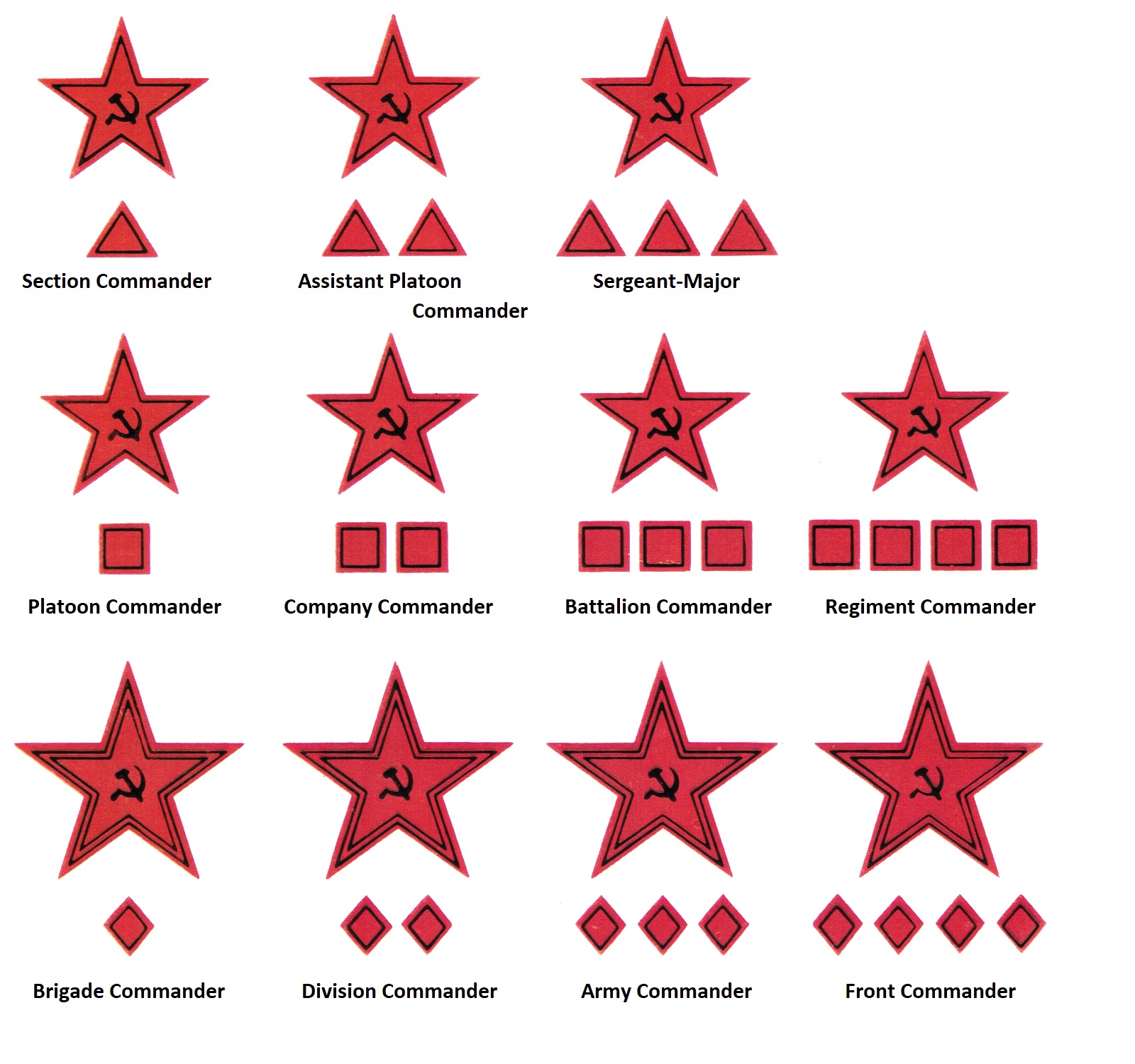
Photos
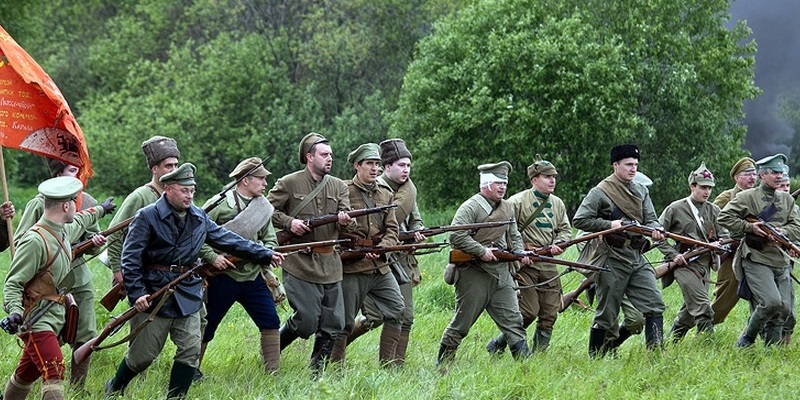
Re-enactors are famously attentive to detail. This is the range of colours and styles that they have researched as correct for the period. (I'm not sure what the guy in the 1919 uniform with green tabs is thinking though, since that is the uniform of a border guard.)
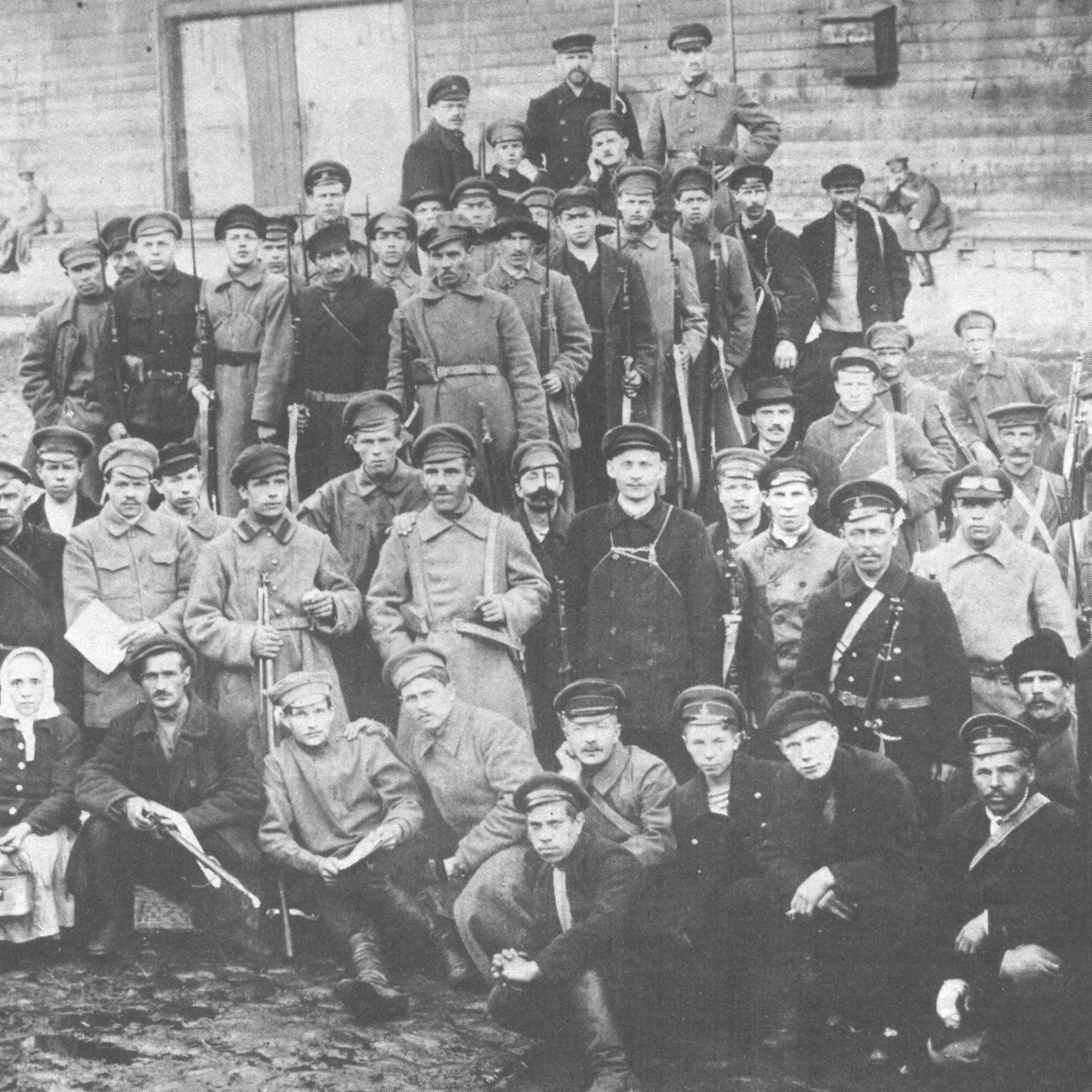
A typical enough Red Army unit. It would appear to be from early in the war, possibly Red Guard, based on men still having the coloured tabs on the greatcoats and the sailors mixed in.
Most of them are wearing uniforms, but almost no two alike.
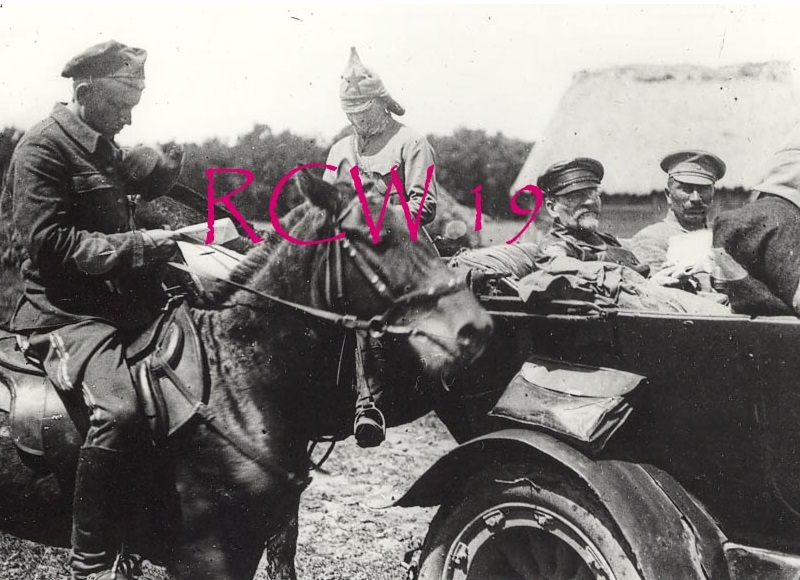
Photo: courtesy of Nik Cornish
The man on the left has a dark ex-officer tunic and what are likely blue trousers with a stripe from WWI stock. Note how he has batted the crown of his cap right back. I don't recognise the sleeve device.
The man behind has shlem without the cockade in the star.
The near pristine cap and moustache of the right-most commander makes me wonder if he is not a military specialist. The bearded man appears to have civilian leather coat and hat and may well be his commissar.